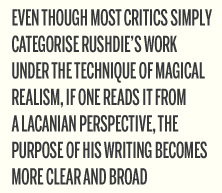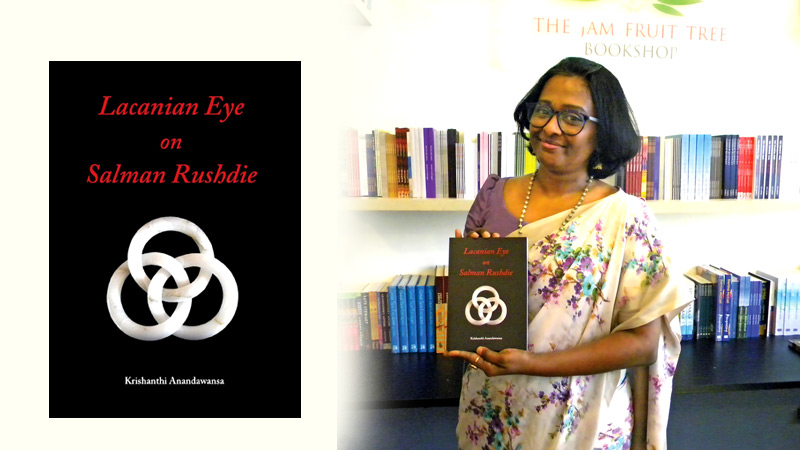Krishanthi Anandawansa was primarily a creative writer and poet before she published her book, “Lacanian Eye on Salman Rushdie”.
She wrote this as her PhD thesis purely out of her love and curiosity for Rushdie’s work, and most importantly for the unique and eye-opening philosophy which she found in his literary creations.
 As a Peradeniya University graduate and a senior lecturer at the Department of Languages at Kotelawala Defence University, Krishanthi published her first book, a poetry collection titled, “I Picture the Mosaic”, in 2009. This was with the support of Carl Muller, who was impressed with her poetry reading during a university event he was invited to.
As a Peradeniya University graduate and a senior lecturer at the Department of Languages at Kotelawala Defence University, Krishanthi published her first book, a poetry collection titled, “I Picture the Mosaic”, in 2009. This was with the support of Carl Muller, who was impressed with her poetry reading during a university event he was invited to.
“Lacanian Eye on Salman Rushdie”, which was published under The Jam Fruit Tree Publications, is her third book with a fourth on the way.
Krishanthi was born and raised in Sharjah, UAE, and spent nine years there before moving back to Sri Lanka. Her mother, who is an avid creative writer herself, encouraged her to write, but mainly in Sinhala. However, considering her upbringing, she was more comfortable with English and Sinhala felt more like a second language to her.
Culture shock
This and the culture shock of the Sri Lankan civil war, made Krishanthi reflect on her sense of belonging from a young age. This also motivated her to do her PhD thesis on Rushdie, since in his work, he mainly speaks about the notion of belonging and not belonging.
The controversy that surrounded his writing also aroused curiosity in Krishanthi and the need to question and understand why some of his books were banned, further fed her interest.
“People don’t like to change or question their views, or think broad mindedly. They see it as a threat and therefore build these symbolic barriers and become extremely fixated on their views,” said Krishanthi.
According to her, Salman Rushdie veers off traditional thinking patterns and projects alternatives in his storylines. Krishanthi wanted to know why he is doing that. “I admit, Rushdie is a writer who is difficult to decipher. He is also a historian by nature and holds a vast knowledge within him,” she said.
Krishanthi explained that many people water down Rushdie’s work into magic and fantasy. Rushdie himself says that when it comes to using the technique of magical realism, many get carried away by the magic and forget about the ‘realism’ part. Krishanthi in her book, explains how the magic in Salman Rushdie’s books were actually derived from the truth. It is based on the concept that whatever that is real now was once an imagination.
The Lacanian theory, introduced by psychoanalyst Jacques Lacan, talks about three basic concepts. The Imaginary, the Symbolic and the Real. The Imaginary is what you think of yourself and others, which is an assumption and purely in the imaginary domain. The Symbolic is the existing physical reality that we see. The Real however, is the larger consciousness out there which is not yet tangible for us. Krishanthi’s book brings forth how Salman Rushdie’s work combines the Imaginary and the Real.
Purpose
Even though most critics simply categorise Rushdie’s work under the technique of magical realism, if one reads it from a Lacanian perspective, the purpose of his writing becomes more clear and broad to the readers. The Lacanian theory concentrates on the Self, and the debate between our self and our desire.
This desire, being termed as the Other. Therefore the Lacanian perspective essentially develops the self towards thinking alternative realities and how you have to be different in order to find solutions in real life. Krishanthi explained how this is all about understanding ourselves and going beyond ourselves as well. “It’s a very refreshing way of looking at postcolonial literature,” says Krishanthi.
“Magic is exaggeration but exaggeration is sometimes needed to understand and highlight these ideologies which would be concealed and go unnoticed if not.”
Salman Rushdie in the Lacanian perspective explains that fiction is imagination created out of reality. Hence, what is not true, has a certain degree of truth to it as well. Krishanthi mentions how in Rushdie’s books such as the “Midnight’s Children”, he writes about an alternate state and how the children of a new era are oppressed because of the symbolic deadlocks we put on ourselves.
“This sheds light on the idea that there’s always a lot of things to do inside of yourself. To understand the works of Rushdie properly, Lacanian tools thus help a lot, since it gives an atomic intervention that could elaborate and place what the author is doing in his stories,” explained Krishanthi.
According to her, in order to understand Rushdie, we need such ambitious and non-cryptic grounds with a critical approach.
Salman Rushdie writes in the “Midnight’s Children”, “Each ‘I’, everyone of the now-six-hundred-million-plus of us, contains a similar multitude. To understand me, you’ll have to swallow the world.” Krishanthi mentions how her research on this subject discusses how there’s nothing as pure. We’re mixed and we are made up of all these multitudes within us. Therefore our perception of self goes way beyond the self we possess.
Since there weren’t many literary experts on this subject whom she could reach out to about this, Krishanthi had to grasp a lot on her own. “It was self-exploration and my own journey as well. I feel like it’s kind of a requirement in the Sri Lankan context since you can use Lacanian tools in many areas beyond literature and education into fields such as economy,” she said.
Since this is an ideological and philosophical study, it required so much thinking and Krishanthi mentions that she is extremely blessed to have a supportive background at home. “Ideological debate is very prominent among liberal thinking people so I humbly hope that this book will get the recognition it deserves,” she said.
Perfect sense
Lacanian studies haven’t been done in this pure sense of combining it with literature. Since this theory studies human beings via pivotal aspects such as language, it made perfect sense to Krishanthi to use it with literature.
She recalls how she had a lot of problems when finding a publisher for this book internationally because once they see the name ‘Rushdie’, the controversy surrounding him makes them reject the book. Therefore she decided to first start locally in order to reach the global audience.
Krishanthi, as a holistic person, loves to share what she knows and it’s not just academically. Inspired by her own mother who was actively engaged in music, she too became a musician who can play several instruments by the ear. “I did everything I possibly could, including sports. You name it, I was there,” Krishanthi recalled.
She loves being a creative writer outside of her academic work and was brilliant at English from a young age. After publishing another poetry collection in 2014 titled, “Simply Freckled”, she took a break from publishing books. Still, she wrote on and off and won several awards in between.
Since this book is an academic project based on literature and philosophy, it’s different from a creative project like poetry and stories. “Balancing my work and my studies and keeping the peace of my mind was a huge challenge,” said Krishanthi. “It took me seven and a half years to come up with everything but only got one and a half years to solely work on this. I continuously spent sleepless nights and it sometimes even affected my health. This is my baby, my burden and my relief. Today I’m really happy because it was all worth it.”
Krishanthi thanked her supervisors, seniors and editors for encouraging her and supporting her to publish this. She feels as if everybody has done her PhD with her.
Krishanthi was fascinated by the literary world of Salman Rushdie and wanted her project to open the minds and hearts of other literary enthusiasts and have them look into his work with an open minded, interesting and fresh perspective which would improve and influence their lives and minds in a positive manner.
Krishanthi, through her book, sheds light on the notion that most people are hesitant to dream or imagine. She discusses the importance of not fixating on the same things and how one can expand their experiences by questioning, powerful imagination and free thinking.
In her book she has written, “The stars forever remain in the very desire to dream.” She believes that if we can always dream and imagine, humankind will constantly reach new advancements and heights that truly matter.
“I hope that the message of this book will get across to the readers. And if I succeed in it, that would be my ultimate joy,” said the author.









